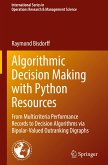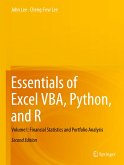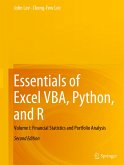This book describes Python3 programming resources for implementing decision aiding algorithms in the context of a bipolar-valued outranking approach. These computing resources, made available under the name Digraph3, are useful in the field of Algorithmic Decision Theory and more specifically in outranking-based Multiple-Criteria Decision Aiding (MCDA).
The first part of the book presents a set of tutorials introducing the Digraph3 collection of Python3 modules and its main objects, such as bipolar-valued digraphs and outranking digraphs. In eight methodological chapters, the second part illustrates multiple-criteria evaluation models and decision algorithms. These chapters are largely problem-oriented and demonstrate how to edit a new multiple-criteria performance tableau, how to build a best choice recommendation, how to compute the winner of an election and how to make rankings or ratings using incommensurable criteria.
The book's third part presents three real-world decision case studies, while the fourth part addresses more advanced topics, such as computing ordinal correlations between bipolar-valued outranking digraphs, computing kernels in bipolar-valued digraphs, testing for confidence or stability of outranking statements when facing uncertain or solely ordinal criteria significance weights, and tempering plurality tyranny effects in social choice problems. The fifth and last part is more specifically focused on working with undirected graphs, tree graphs and forests. The closing chapter explores comparability, split, interval and permutation graphs.
The book is primarily intended for graduate students in management sciences, computational statistics and operations research. The chapters presenting algorithms for ranking multicriteria performance records will be of computational interest for designers of web recommender systems. Similarly, the relative and absolute quantile-rating algorithms, discussed and illustrated in several chapters, will be of practical interest to public and private performance auditors.
The first part of the book presents a set of tutorials introducing the Digraph3 collection of Python3 modules and its main objects, such as bipolar-valued digraphs and outranking digraphs. In eight methodological chapters, the second part illustrates multiple-criteria evaluation models and decision algorithms. These chapters are largely problem-oriented and demonstrate how to edit a new multiple-criteria performance tableau, how to build a best choice recommendation, how to compute the winner of an election and how to make rankings or ratings using incommensurable criteria.
The book's third part presents three real-world decision case studies, while the fourth part addresses more advanced topics, such as computing ordinal correlations between bipolar-valued outranking digraphs, computing kernels in bipolar-valued digraphs, testing for confidence or stability of outranking statements when facing uncertain or solely ordinal criteria significance weights, and tempering plurality tyranny effects in social choice problems. The fifth and last part is more specifically focused on working with undirected graphs, tree graphs and forests. The closing chapter explores comparability, split, interval and permutation graphs.
The book is primarily intended for graduate students in management sciences, computational statistics and operations research. The chapters presenting algorithms for ranking multicriteria performance records will be of computational interest for designers of web recommender systems. Similarly, the relative and absolute quantile-rating algorithms, discussed and illustrated in several chapters, will be of practical interest to public and private performance auditors.
"The book ... guides reader through each topic through sub-chapters and using links, even leading to the python.org interface for related content. From the moment reader download the Diagraph3 software, it helps reader understand with copyable code snippets and separate warning Note content. It guides reader through the operation of the algorithm through concrete, solved example." (Rózsa Horváth-Bokor, zbMATH 1497.91004, 2022)








